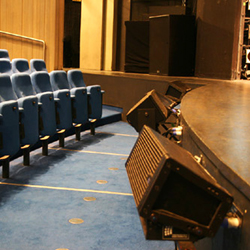A well-designed main/primary loudspeaker system is expected to provide clear and intelligible sound to the entire audience.
Over the years our industry has benefitted from a steadily growing selection of types and configurations of primary loudspeakers to do this; they possess the specific characteristics (performance and physical) that we need in our base inventory, or for a given project, or to solve a specific problem.
Many of these varied types of products are also available over a wide range of size, quality and price options.
Yet more often than not when we deploy primary loudspeaker devices – singly or in all manner of arrays – there still may be holes in the coverage. This occurs for a number of valid reasons:
• Not enough primary loudspeakers for the specific venue;
• The need to avoid aiming primary loudspeakers to cover all of the front seats (at high frequencies) due to the low and mid frequency energy that ends up on stage or in the orchestra pit;
• Box seats that are located close to the stage (proscenium) that can’t be covered by the primary loudspeakers due to their close proximity;
• Architectural elements, including balconies and columns, that may shadow the sound projected from the primary system;
• The depth of seating (indoors and outdoors) can require additional devices, located further into the seating area, to “kick it up” a bit;
• The need to provide sound to contained areas to the sides of the stage.
And the list goes on.
Coverage is an absolutely critical performance characteristic, at the very heart of what we must provide. The challenge to be met is supplying the correct number of fill loudspeakers that individually, or collectively, insure the coverage needed to fill the existing hole(s) and to ensure minimal overlap into the coverage that is already provided.
Few low-profile fill loudspeakers exhibit narrow coverage patterns across a wide frequency range and are also inherently restricted in acoustic output. Therefore their throw is restricted, although this actually may be of benefit in some cases.
Further, in many cases, clear and intelligible coverage is not our only concern. There often is an equally important need to provide or maintain localization to the source, and for as many seats as possible.
Localization is defined as the aural perception that the sound is coming from the apparent point of origin (where we locate the source visually, usually on the stage or platform) or, in larger venues and specifically for those seated further away, from the stage itself.
The need for localization is no more prevalent than in sound reinforcement for musical theater, but in many other venues and types of productions there may be just as much desire to provide realistic imaging. This can be accomplished (or improved) using fill loudspeakers plus various processing functions, measurement and our ears.
We see these challenges often, usually when someone has misinformed us, or forgotten to mention key information, or has “changed their mind” on seating location/configuration.
So we grab what we can (assuming that we can) and set it/them up to fill any holes. It might be sloppy but it usually solves or reduces the immediate problem.















